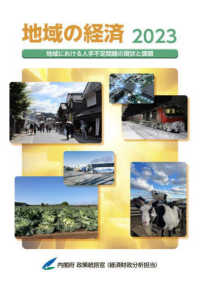- ホーム
- > 洋書
- > 英文書
- > History / World
Full Description
Archaeological exploration of burial practices continues to provide insight into socio-historical cultural practices, behaviours, and attitudes to individual community members at the point of their death. This insight speaks to dominant social practices or beliefs within a population and may demonstrate connectedness with other regional localities. The ever-expanding body of evidence from burial settings across Mainland Southeast Asia, incorporating considerations of the range of social identities prominent in archaeological discourse, demonstrates the presence of complex, vibrant, and diverse practices throughout this region geographically and across time.
The Identity at Death of the Old and Young explores four burial sites from the southeast Asian mainland, populated in the Neolithic to Iron Age, to discuss burial behaviour in relation to the old and young. While a biological sex identity is considered, the study primarily explores the potentiality for age identities as a defining social characteristic at, and between, each site. A range of burial variables, normative and non-normative, are interrogated to illuminate and discuss social attitudes and behaviours toward each cohort.
This book provides the first comprehensive study of elderly subjects in mortuary settings from Mainland Southeast Asia. It incorporates emerging ageing methodologies and provides a regional perspective from discrete sites that contribute to the growing focus of older subjects in archaeological settings internationally.
Contents
Abstract
1 Introduction
2 Mortuary Archaeology, Mourning and Grief
3 Gender, Age and Ageing
4 Mainland Southeast Asia: Overview and Site Discussion
5 Materials and Methods
6 Results: Khok Phanom Di
7 Results: Ban Non Wat
8 Results: Ban Lum Khao
9 Results: Noen U-Loke
10 Results: Generalised Linear Modelling
11 Discussion: Age as a Characterisation of Identity in Southeast Asia
12 Regionality and Resilience Theories in the Context of Southeast Asia
13 Conclusion
References
Appendix 1: Reallocated Adult Age Categories
Appendix 2: Funerary Variable Descriptions
Appendix 3: Burials by site including those excluded from analysis








